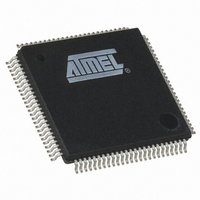AT43USB320A-AC Atmel, AT43USB320A-AC Datasheet - Page 54

AT43USB320A-AC
Manufacturer Part Number
AT43USB320A-AC
Description
IC USB MCU EMBED HUB AVR 100LQFP
Manufacturer
Atmel
Series
AVR®r
Datasheet
1.AT43USB320A-AC.pdf
(115 pages)
Specifications of AT43USB320A-AC
Applications
USB Hub/Microcontroller
Core Processor
AVR
Controller Series
AT43USB
Ram Size
512 x 8
Interface
SPI Serial, USB, UART
Number Of I /o
32
Voltage - Supply
4.4 V ~ 5.25 V
Operating Temperature
0°C ~ 70°C
Mounting Type
Surface Mount
Package / Case
100-LQFP
Lead Free Status / RoHS Status
Contains lead / RoHS non-compliant
Program Memory Type
-
Available stocks
Company
Part Number
Manufacturer
Quantity
Price
SS Pin Functionality
Data Modes
Figure 17. SPI Transfer Format with CPHA = 0 and DORD = 0
Note:
54
* Not defined but normally LSB of character just received.
SCK (CPOL = 0)
SCK (CPOL = 1)
AT43USB320A
(For Reference)
SCK Cycle #
(From Master)
SS (To Slave)
(From Slave)
MOSI
MISO
When the SPI is configured as a master (MSTR in SPCR is set), the user can determine the
direction of the SS pin. If SS is configured as an output, the pin is a general output pin which
does not affect the SPI system. If SS is configured as an input, it must be held high to ensure
Master SPI operation. If the SS pin is driven low by peripheral circuitry when the SPI is config-
ured as master with the SS pin defined as an input, the SPI system interprets this as another
master selecting the SPI as a slave and starting to send data to it. To avoid bus contention, the
SPI system takes the following actions:
1. The MSTR bit in SPCR is cleared and the SPI system becomes a slave. As a result of
2. The SPIF flag in SPSR is set, and if the SPI interrupt is enabled and the I-bit in SREG
Thus, when interrupt-driven SPI transmittal is used in master mode, and there exists a possi-
bility that SS is driven low, the interrupt should always check that the MSTR bit is still set.
Once the MSTR bit has been cleared by a slave select, it must be set by the user to re-enable
SPI master mode.
When the SPI is configured as a slave, the SS pin is always input. When SS is held low, the
SPI is activated and MISO becomes an output if configured so by the user. All other pins are
inputs. When SS is driven high, all pins are inputs, and the SPI is passive, which means that it
will not receive incoming data. Note that the SPI logic will be reset once the SS pin is brought
high. If the SS pin is brought high during a transmission, the SPI will stop sending and receiv-
ing immediately and both data received and data sent must be considered as lost.
There are four combinations of SCK phase and polarity with respect to serial data, which are
determined by control bits CPHA and CPOL. The SPI data transfer formats are shown in Fig-
ure 17 and Figure 18.
the SPI becoming a slave, the MOSI and SCK pins become inputs.
are set, the interrupt routine will be executed.
MSB
MSB
1
2
6
6
3
5
5
4
4
4
5
3
3
6
2
2
7
1
1
LSB
LSB
8
*
1443E–USB–4/04













